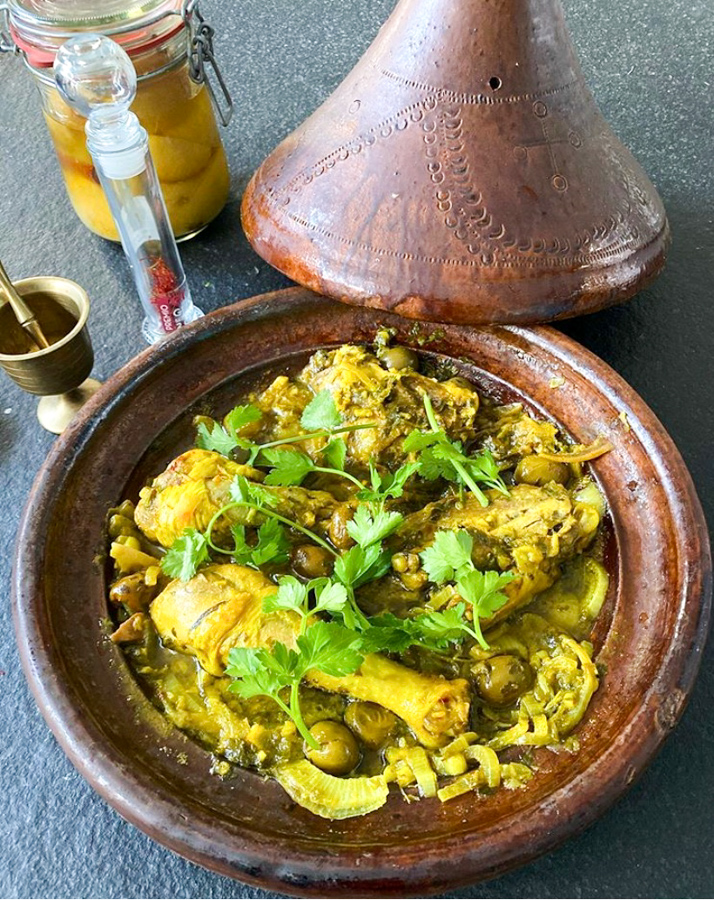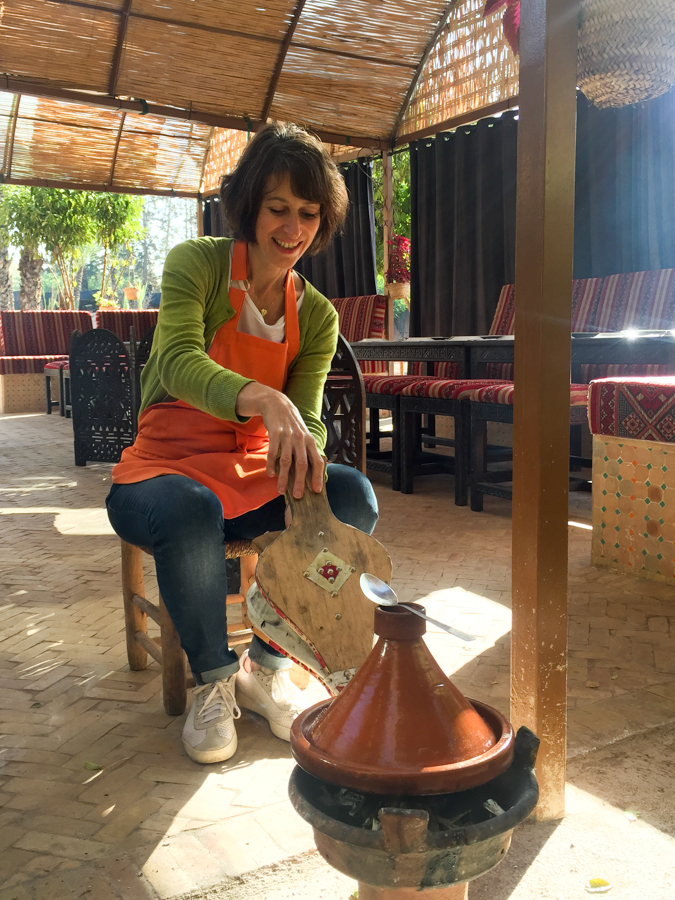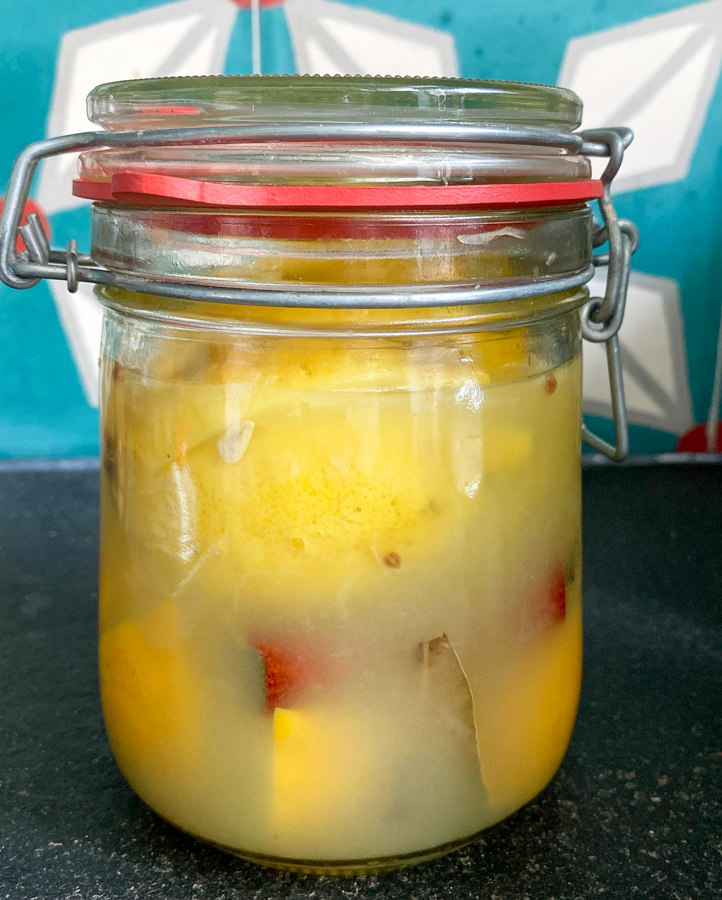Cooking in confinement: Chicken, preserved lemon and olive tagine

I feel wistful writing this post, as I had planned to be in Morocco this week, leading a group of 11 intrepid travelers through the south of the country with my Moroccan-born partner Fouad of France Azur Excursions. We had meticulously planned every moment of this nine-day trip for several months, and we were all set to go when countries began to close their borders in reaction to the spread of Coronavirus. Happily, our entire group agreed to postpone the trip until this time next year, so we have something to dream about as we hole ourselves up in our homes for the next few weeks. We are also adding a second trip next spring, giving others an opportunity to join us.
The next best thing to being in Morocco is recreating its fragrantly spiced dishes in your own kitchen. In Morocco, as in Nice, cooking is the domain of women — which is not to say that men never cook, as Fouad proves with his skill in the kitchen. During our travels, however, many of our best meals have been in smaller riads rather than restaurants, as this is closer to the experience of eating in someone’s home. At these places, you can bet that there are different generations of women in the kitchen, pouring love into everything they make.
Tagines are at the heart of Moroccan cooking: the word refers not just to the dish, but to the round clay vessel with a cone-shaped lid used for the cooking. Although you can certainly cook a tagine in a heavy saucepan or Dutch oven with a lid, there is something unique about the way food cooks in a tagine, which is usually placed directly over a flame so that that the juices reduce and eventually caramelize. For a tagine to be successful, the ingredients should be sticking a bit to the bottom by the end of the cooking time, and the juices should be thickened but still present. The simplicity of the assembly might make tagine seem foolproof, but it requires just the right amount of attention while cooking — not too much and not too little.
While in Marrakech in November, I was fortunate to take a cooking class at the Amal Nonprofit Center, which helps women overcome adversity by training them to cook and teaching them other basic life skills so that they can go on to find jobs. There is even a follow-up for the next several months to make sure they are adjusting to working life. Some of the women come from extreme poverty, others have been abused or are dealing with disabilities. During our class, three of the trainees were teaching us, along with a student named Doha who acted as the translator (into English) for our international group of about 12 people.
One of the dishes we prepared that day was chicken with preserved lemon and olives, a dish that is popular all over Morocco. This was the first Moroccan dish I ever tasted, and I’ve always loved its tongue-tingling balance of citrus and salt. To make it, we used free-range chicken obtained from a local farm, homemade preserved lemons, and the freshest spices — who would have guessed that Doha prefers supermarket spices to those sold at the souk, which she explained are sometimes not of the highest quality?
If you are used to starting many dishes by sautéing onions in oil, the method for this one comes as a surprise. First, you marinate the chicken with the spices and other flavorings for as much time as you can spare, then you simply pile up raw onions with the other ingredients in the tagine, pour the oil over top, and put it on the burner. The oil runs through the mixture, eventually reaching the bottom where it will help the onions caramelize. The preserved lemon and olives go in during the last 10 minutes of cooking time, but otherwise the dish requires little supervision. In fact, as Fouad’s mother used to say to him when he was a child, if you peek too often you will let the flavor out with the steam!
Before making it back in my Nice kitchen, I decided to preserve my own lemons using a recipe by Paula Wolfert that I found online. I had recently brought home a haul of lemons from my friends’ vegetable garden in Riva, on the Ligurian coast, and this seemed the perfect way to extend the pleasure of this small luxury. It so happened that, a few weeks after packing the lemons into a jar with salt and lemon juice, I found myself on lock-down. Luckily, I had the other ingredients on hand to conjure up a little of the atmosphere I had hoped to be enjoying this week.
If you can’t find preserved lemons, it’s well worth taking the small amount of time (and patience) required to make them, as fresh lemons are no substitute in this recipe. As for the olives, though medium-sized greenish-purple olives are most traditional, you can use what you have. Chicken legs are the best choice for slow cooking — bone-in chicken breast would also be fine, while boneless chicken would not take well to cooking for this long. In the end, though, it’s the spices that make this dish Moroccan: turmeric, ginger, black pepper and a pinch of saffron if you have it. Your home will fill with an aroma that transports you to another country where life is lived at a gentler pace.

Chicken tagine with preserved lemon and olives
Serves 2
This recipe is slightly adapted from the one I learned at the Amal Nonprofit Center in Marrakech. Doha told us that you can prepare a larger amount of the chopped parsley and coriander mixture, add oil and keep it in the refrigerator for weeks — a great way to not let fresh herbs go to waste. If you don’t have a tagine, go ahead and use a heavy pot with a lid or Dutch oven — it will still be delicious. In Morocco, tagine is generally served with flatbread rather than couscous, but you can do as you wish!
2 chicken legs (or one bone-in chicken breast and one leg), with or without the skin according to your preference
1/2 tsp black pepper
2 tsp ground ginger
2 tsp turmeric powder
1/2 tsp salt
4 garlic cloves, minced
3 tbsp finely chopped parsley and cilantro (coriander), mixed
A pinch of saffron
1/2 preserved lemon
Juice of half a fresh lemon
1/2 cup water (125 ml)
1 medium onion, cut in half and thinly sliced
2 tbsp olive oil
2 tbsp vegetable oil
A handful of olives, preferably green or pale purple
Cut the chicken legs in half and place them in a bowl (with the chicken breast, if using). In a small bowl, combine the spices, salt, garlic, parsley and cilantro, and saffron, rubbing it in the palm of your hand to reduce it to a powder (you can also use a mortar for this). Add the chopped pulp of the preserved lemon — save the rind — along with the the lemon juice and water. Pour this mixture over the chicken and massage the chicken with your hands to help it absorb the flavors. Set aside for 30 mins to 2 hours if you can — if not, that’s ok.
Spread the sliced onion over the base of your tagine or pot, then arrange the chicken over top and pour the marinade over the chicken. Cover with a lid and place on medium heat until it starts to bubble. Reduce the heat and cook on low heat for 45 minutes, without peeking too often. Add a little more water if it starts to look dry. Turn the chicken about halfway through this time.
Meanwhile, thinly slice the preserved lemon rind. After the chicken has cooked for 45 minutes, arrange the preserved lemon rind and olives over top. Cover again and cook for 10-15 more minutes.
At this stage, if the juices have not reduced, remove the chicken to a serving platter, keep warm and reduce the juices until they are slightly thickened.
Decorate with fresh cilantro and serve.






Leave a Reply
Want to join the discussion?Feel free to contribute!